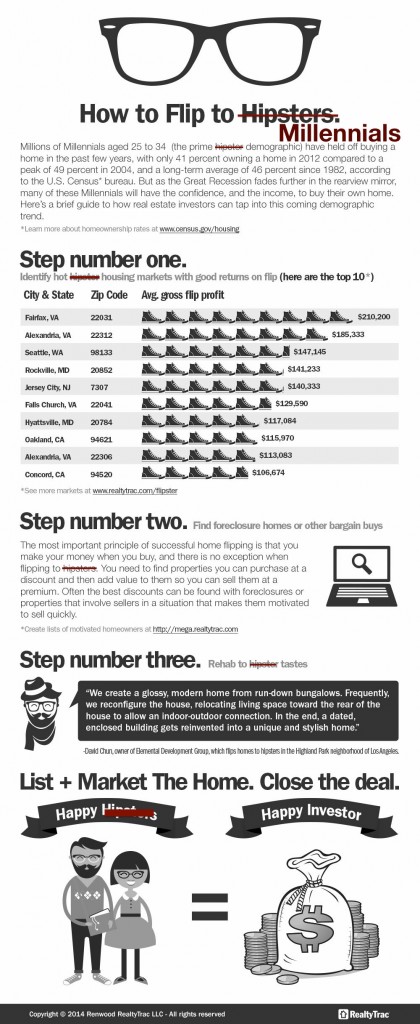Infographic: House Flipping to Millennials, Not Hipsters

We’ve modified RealtyTrac’s infographic. Full graphic below.
RealtyTrac has released a “flipster” report: data, graphics and an infographic all meant to explain where the “hipster” demographic is buying and renting right now. The infographic we show below outlines what an investor can do to flip a home specifically for the hipster market — hence, flipster.
There’s only one problem: When it comes to flipping, RealtyTrac is defining “hipster” very broadly — as anyone between the ages of 25 and 34 who lives in a walkable area. Look at your 23-year-old nephew working on Wall Street and clubbing with his frat brothers after hours. Is he a hipster? How about the sweet 19-year-old girl from Williamsport who works at the CVS near your house and invites you to weekly Pot Lucks for Christ at her church? Is she a hipster? It’s possible — I don’t say no — but the archetypal “hipster” connotations probably don’t apply.
That’s why we’ve changed the graphic below to illuminate what RealtyTrac is actually getting out: how to attract young people to homeownership — a noble goal, and one that’s very important to the housing recovery and the long-term health of the housing market. Below, some of RealtyTrac’s explanation for its research, with our caveat that “hipster” does not mean hipster.
Hipsters have been accused of holding back a more robust housing recovery because of their low homeownership rates and lackluster household formation.
Certainly there is data to back this up: the U.S. Census bureau shows homeownership rates for hipsters (our term, not theirs) — comprised of those aged 25 to 34 — was at 41 percent in 2012. That is well off the average hipster homeownership rate of 46 percent from 1982 to present, and it’s certainly below the high of more than 49 percent in 2004.
The hipster homeownership rate has been below the long-term average since 2009, and the deficit in hipster homeowners because of that below-average period stands at approximately 2 million.
Why are hipsters not becoming homeowners? In part because many are living with their parents longer rather than forming their own households, according to analyses of Census bureau data by PewResearchCenter focusing on Millennials — a demographic heavy with hipsters.
Does the word “hipster” look funny to you now? It looks funny to me now that I’ve typed it so many times.
Anyway.
Take a gander at the full infographic and let us know your deep, hipsterish thoughts.

Courtesy RealtyTrac


